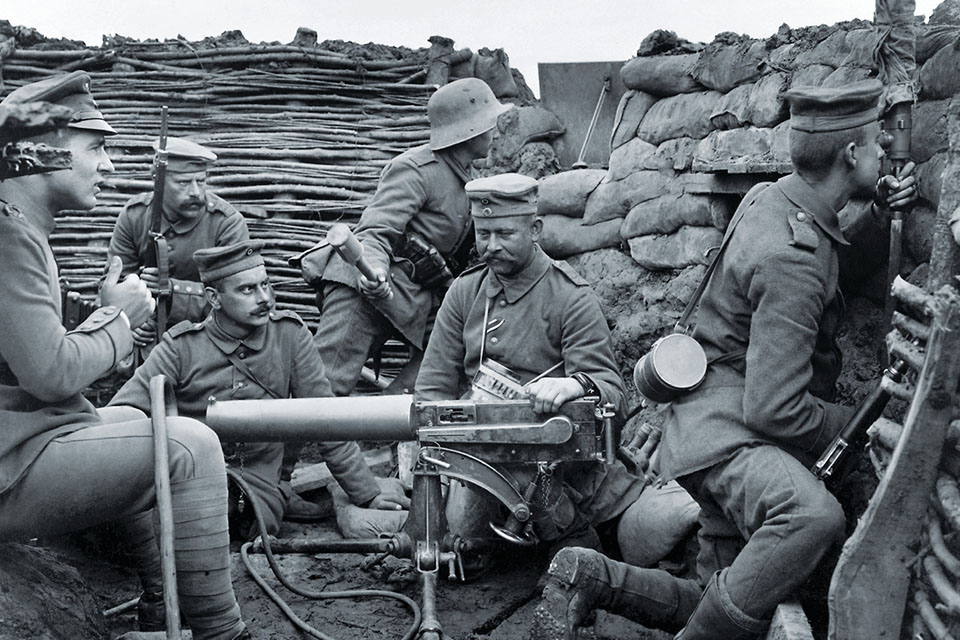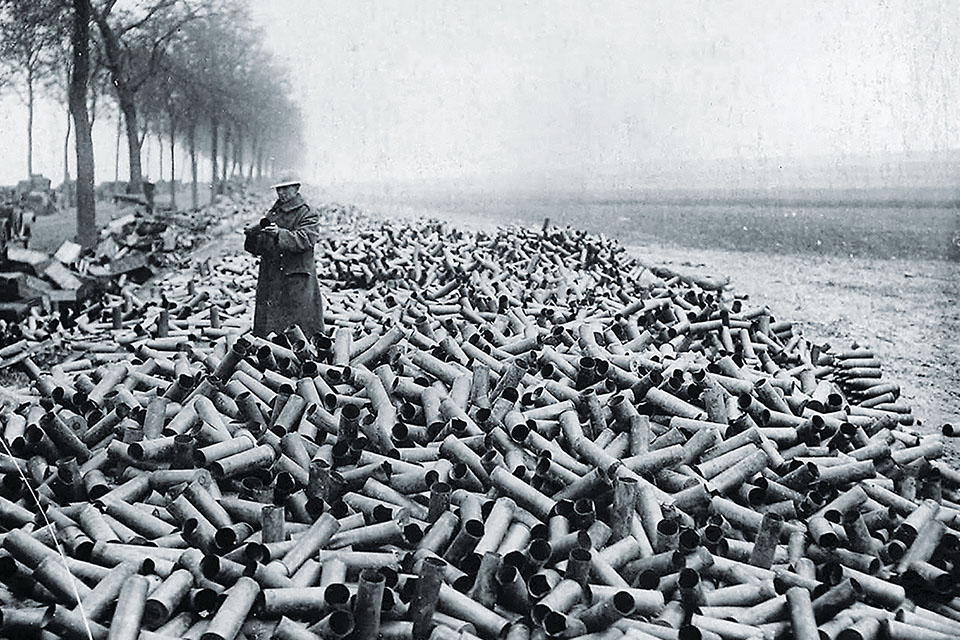By January 1915 World War I was five months old, and the major European powers were entrenched in increasingly savage warfare. The battles at Liège and Ypres in Belgium, at Tannenberg in East Prussia, along the Marne in France and in Austro-Hungarian Galicia had already demonstrated the war was likely to be calamitous for all participants. The level of destruction, alarmingly high casualty rates and combatants’ growing reliance on extensive trench systems that discouraged maneuver warfare all indicated the conflict would be long, brutal and expensive in both blood and treasure.
This reality not only stunned the people of the warring nations but also contradicted the expectations of the vast majority of generals, government officials and military analysts of the time. In the opening weeks of the conflict—that all too brief period marked by patriotic parades, rousing speeches and dashing cavalry charges—“experts” on all sides of the conflict had predicted it would be over by Christmas.
While their assumption seemed logical enough in light of Europe’s recent military history, the advent of modern weaponry and widespread acceptance of the concept of total war soon proved the phrase “over by Christmas” both ridiculously optimistic and cruelly inaccurate.

In retrospect it is not difficult to understand why both the military and civilian intelligentsia of the early 20th century held the strong conviction any future war would be relatively short in duration. The continent’s recent experience seemed to support the notion.
In the mid-19th century Prussia had provoked three wars—the five-week German-Danish War of 1864, the six-week Austro-Prussian War of 1866 and the 1870–71 Franco-Prussian War, which ran some nine months but involved only eight weeks of fighting—that ultimately led to the formation of the German empire. Prussia’s string of brilliant and seemingly effortless military victories impressed the period’s “thought leaders,” who assumed any subsequent conflict would follow the same pattern. This expectation was so ingrained in the minds of the generals and statesmen of Western and Central Europe that they completely ignored the implications of the 1861–65 American Civil War, the 1877–78 Russo-Turkish War and the 1904–05 Russo-Japanese War, each of which ushered in modern tactics and generated massive casualties.
Another factor causing military leaders to tragically misjudge the nature and length of a future war was their fundamental misunderstanding of how such technologically enhanced weapons as rifled artillery, magazine-fed rifles, machine guns, aircraft and more powerful explosives had forever altered the nature of combat. These newer, more lethal weapons had industrialized the practice of war, expanding the relatively compact battlefields of earlier ages into vast killing fields, across which massed formations marching in impressive and colorful array were quickly and efficiently reduced to shattered equipment and scattered corpses.
Ironically, the few military leaders who took into account the advances in weaponry drew entirely incorrect conclusions. They assumed such weapons would allow an army to quickly overwhelm an enemy’s defenses, making offense the preferred tactic. This attitude took graphic expression in the strategy developed by Louis Loyzeau de Grandmaison, chief of operations of the French General Staff, who proclaimed that the army, “returning to its traditions, recognizes no law save that of the offensive.” Unfortunately for millions of soldiers, this reliance on a primarily offensive strategy wholly ignored the dictum of Prussian general and strategist Carl von Clausewitz that a defensive strategy is the stronger form of modern warfare. As it turned out, the advent of advanced weaponry made the defense supreme on the Western Front, prompting four years of costly, fruitless stalemate.
Another rationale for the belief modern wars were destined to be short centered on the economics of armed conflict. Those who considered the issue at all were essentially unanimous in their assumption that even the most financially robust nations could not long sustain the enormous expenditures modern war would entail. After all, the new military technologies would consume vast amounts of money and resources, as would the need to maintain large standing armies and navies. The assumption that no economy could sustain an extended conflict was reflected in the early stages of the war when both Britain and Russia optimistically proclaimed they would conduct “business as usual,” neither restructuring its economy to finance a lengthy war. Yet as the war dragged on into 1915, London and St. Petersburg joined most other belligerent nations in putting their economies on a “war footing,” mobilizing their markets and means of production and distribution in order to maintain its armies in the field.

Finally, the conviction regarding the brevity of modern war arose from a prevailing contemporary belief that armed conflict was an acceptable means of solving international disputes. In general the leaders and people of the soon-to-be combatant states agreed with Clausewitz that war is simply the continuation of politics through other means. In 1914 war was, therefore, seen as a viable instrument of international policy, participants assuming their political goals justified the expenditure of relatively few lives. Had Kaiser Wilhelm II, Tsar Nicholas II and the heads of state of England, France and Italy had any idea of the ultimate human and financial cost of the war, they almost certainly would have avoided entering into such an enterprise. In the end, victors and vanquished suffered equally. Ironically, the horror of the conflict made most subsequent European leaders and their people staunchly anti-war—a sentiment that informed British and French responses to Adolf Hitler and the rise of Nazism and, in a sense, made World War II inevitable.
World War I was far from over by Christmas 1914, of course. Indeed, casualties incurred by year’s end indicated all too clearly the struggle would be far longer and bloodier than analysts had imagined. By December 31 France had suffered some 995,000 total casualties; Russia, about the same; Germany, nearly 700,000; and Britain, just shy of 100,000, representing some 63 percent of its committed manpower.
While the conflict was not over by Dec. 25, 1914, the holiday did engender one of the most poignant and touching episodes of the war. On the first Christmas Eve of the conflict, in various sectors along the Western Front, German troops began singing carols and putting up decorations, and British and French troops did likewise. On Christmas Day emboldened troops met in no man’s land to drink toasts, exchange gifts and even play a little soccer. When appalled superior officers put a stop to the informal truce, the soldiers returned to their respective trenches and resumed the fight. As the war dragged on the embittered opponents met any attempts at similar fraternization with artillery or machine gun fire.
Anyone still foolish enough to believe that a mass-scale modern war can be handily won “by Christmas” should recall the carnage of World War I and thoughtfully recite the closing stanza of Scottish-born poet Frederick Niven’s “A Carol From Flanders”:
O ye who read this truthful rime
From Flanders, kneel and say:
God speed the time when every day
Shall be as Christmas Day.
James Y. Simms Jr., a former U.S. Marine Corps rifle platoon leader, is a professor emeritus of Russian and modern European history at Virginia’s Hampden-Sydney College. For further reading he recommends The Oxford Illustrated History of the First World War, edited by Hew Strachan; The First World War: A Very Short Introduction, by Michael Howard; and The Pity of War: Explaining World War I, by Niall Ferguson.
First published in Military History Magazine’s January 2017 issue.





